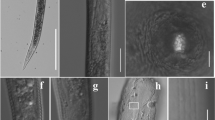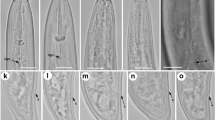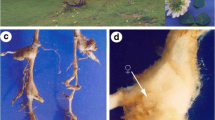Abstract
The non-cyst forming heteroderid nematode Cryphodera brinkmani was detected in Italy parasitizing roots of Japanese white pine bonsai (Pinus parviflora) trees imported from Japan. Morphology and morphometrical traits of the intercepted population on this new host for C. brinkmani were in agreement with the original description, except for some minor differences on male morphology. Integrative molecular data for this species were obtained using D2-D3 expansion regions of 28S rDNA, ITS1-rDNA, the partial 18S rDNA, and the protein-coding mitochondrial gene, cytochrome oxidase c subunit I (COI). The phylogenetic relationships of this species with other representatives of non-cyst and cyst-forming Heteroderidae using ITS1 are presented and indicated that C. brinkmani clustered together with other Cryphodera spp. and with Meloidodera alni suggesting a monophyletic origin of non-cyst forming nematodes (Heteroderinae sensu Luc et al. 1978), which have been considered close to the ancestor of most species of Heteroderidae. Histological observations of P. parviflora feeder roots infected by C. brinkmani indicated that nematode females induce similar anatomical alterations to those reported for C. kalesari, consisting of formation of a single uninucleate giant cell (nurse cell) with hypertrophied nucleus, prominenet nucleolus, thickened cell wall and expanding into the stele and in contact of xylem, vacuum cambium and phloem. These findings are in agreement with the results of the phylogenetic analysis and indicate a close relationship in the plant responses induced by Cryphodera nematode females with those caused by the genetically related Meloidodera spp., which also induce formation of a uninucletate giant cell.





Similar content being viewed by others
References
Bajaj, H. K., Walia, R. K., Dabur, K. R., & Bhatti, D. S. (1989). Cryphodera kalesari, a new heteroderid nematode species from Haryana, India. Systematic Parasitology, 14, 113–116.
Bajaj, H. K., & Walia, R. K. (2000). Host response to Cryphodera kalesari (Heteroderidae: Nematoda). Nematologia mediterranea, 28, 197–199.
Baldwin, J. G. (1992). Evolution of cyst and noncyst-forming Heteroderidae. Annual Review of Phytopathology, 30, 271–290.
Baum, T. J., Hussey, R. S., & Davis, E. L. (2007). Root-knot and cyst nematode parasitism genes: the molecular basis of plant parasitism. In J. K. Setlow (Ed.), Genetic engineering (pp. 17–43). London: Springer Science.
Bernard, E. C., Handoo, Z. A., Powers, T. O., Donald, P. A., & Heinz, R. D. (2010). Vittatidera zeaphila (Nematoda: Heteroderidae), a new genus and species of cyst nematode parasitic on corn (Zea mays). Journal of Nematology, 42, 139–150.
Boutsika, K., Brown, D. J. F., Phillips, M. S., & Blok, V. C. (2004). Molecular characterisation of the ribosomal DNA of Paratrichodorus macrostylus, P. pachydermus, Trichodorus primitivus and T. similis (Nematoda: Trichodoridae). Nematology, 6, 641–654.
Castillo, P., Vovlas, N., Subbotin, S., & Troccoli, A. (2003). A new root-knot nematode, Meloidogyne baetica n. sp. (Nematoda: Heteroderidae), parasitizing wild olive in Southern Spain. Phytopathology, 93, 1093–1102.
Colbran, R. C. (1966). Studies of plant and soil nematodes. 12. The eucalypt cystoid nematode Cryphodera eucalypti n. g., n. sp. (Nematoda: Heteroderidae) a parasite of eucalypts in Queensland. Queensland Journal of Agricultural and Animal Sciences, 23, 41–47.
Coolen, W. A. (1979). Methods for extraction of Meloidogyne spp. and other nematodes from roots and soil. In F. Lamberti & C. E. Taylor (Eds.), Root-knot nematodes (Meloidogyne species). Systematics, Biology and Control (pp. 317–329). New York: Academic.
Derycke, S., Remerie, T., Vierstraete, A., Backeljau, T., Vanfleteren, J., Vincx, M., & Moens, T. (2005). Mitochondrial DNA variation and cryptic speciation within the free-living marine nematode Pellioditis marina. Marine Ecology Progress Series, 300, 91–103.
Hall, T. A. (1999). BioEdit: a user-friendly biological sequence alignment editor and analysis program for Windows 95/98NT. Nucleic Acids Symposium Serial, 41, 95–98.
Hirata, K., & Yuhara, I. (1986). Plant parasitic nematodes detected from Bonsai trees and Bonsai nurseries. Research Bulletin of the Plant Protection Service, Japan, 22, 111–117.
Hooper, D. J. (1986). Handling, fixing, staining and mounting nematodes. In J. Southey (Ed.), Ministry of Agriculture, Fisheries and Food (6th ed., pp. 59–80). London: Her Majesty’s Stationery Office.
Huelsenbeck, J. P., & Ronquist, F. (2001). MRBAYES: Bayesian inference of phylogenetic trees. Bioinformatics, 17, 754–755.
Inserra, R. N., & Vovlas, N. (1986). Cystoid nematodes and their economic importance. Nematology Circular No. 128 (p. 4). Gainesville: Florida Department of Agriculture and Consumer Services, DPI.
Johansen, D. A. (1940). Plant Microtechnique. New York: McGraw-Hill Book Co.
Karssen, G., & Van Aelst, A. (1999). Description of Cryphodera brinkmani n. sp. (Nematoda: Heteroderidae), a parasite of Pinus thunbergii Parlatore from Japan, including a key to the species of the genus Cryphodera Colbran, 1966. Nematology, 1, 121–130.
Krall, E.L. & Krall, H.A. (1978). [Revision of the plant nematodes of the family Heteroderidae on the basis of trophic specialization of these parasites and their co-evolution with their host plants.] In: Fitogel’mintologicheskie Issledovaniya. Moscow, USSR, Nauka, pp. 39–56.
Luc, M., Taylor, D. P., & Cadet, P. (1978). Description of a new tropical Heteroderidae, Hylonema ivorense n. gen., n. sp., and a new outlook on the family Heteroderidae (Nematoda: Tylenchida). Revue de Nématologie, 1, 73–86.
McCullough, D. G., Work, T. T., Cavey, J. F., Liebhold, A. M., & Marshall, D. (2006). Interceptions of nonindigenous plant pests at US ports of entry and border crossings over a 17-year period. Biological Invasions, 8, 611–630.
Mundo-Ocampo, M., & Baldwin, J. G. (1983). Host response of to Meloidodera spp. (Heteroderidae). Journal of Nematology, 15, 544–554.
Nguyen, C. N., Sturhan, D., & Subbotin, S. A. (2011). Studies on the occurrence abd diversity of Heteroderidae and Meloidogynidae (Nematoda:Tylenchida) in natural forests of Vietnam. Russian Journal of Nematology, 19, 159–172.
Page, R. D. (1996). TreeView: an application to display phylogenetic trees on personal computers. Computer Applications in the Bioscience, 12, 357–358.
Posada, D. (2008). jModelTest: Phylogenetic model averaging. Molecular Biology and Evolution, 25, 1253–1256.
Quénéhervé, P., Topart, P., & Poliakoff, F. (1998). Interception of nematodes on imported bonsai in Martinique. Nematropica, 28, 101–105.
Roques, A., & Auger-Rozenberg, M. A. (2006). Tentative analysis of the interceptions of non-indigenous organisms in Europe during 1995–2004. Bulletin OEPP/EPPO Bulletin, 36, 490–496.
Siddiqi, M. R. (2000). Tylenchida parasites of plants and insects (2nd ed.). Wallingford: CABI Publishing).
Subbotin, S. A., Vierstraete, A., De Ley, P., Rowe, J., Waeyenberge, L., Moens, M., & Vanfleteren, J. R. (2001). Phylogenetic relationships within the cyst-forming nematodes (Nematoda, Heteroderidae) based on analysis of sequences from the ITS regions of ribosomal DNA. Molecular Phylogenetics and Evolution, 21, 1–16.
Subbotin, S. A., Del Prado Vera, I. C., Mundo-Ocampo, M., & Baldwin, J. G. (2011). Identification, phylogeny and phylogeography of circumfenestrate cyst nematodes (Nematoda: Heteroderidae) as inferred from analysis of ITS-rDNA. Nematology, 13, 805–824.
Swofford, D.L. (2003). PAUP*: Phylogenetic Analysis Using Parsimony (and Other Methods) 4.0 Beta. (Florida State University).
Thompson, J. D., Higgins, D. G., & Gibson, T. J. (1994). Clustal W: improving the sensitivity of progressive multiple sequence alignment through sequence weighting, positions-specific gap penalties and weight matrix choice. Nucleic Acids Research, 22, 4673–4680.
Toida, Y. (1984). Nematode species from mulberry fields and their geographical distribution in Japan. Japanese Journal of Nematology, 14, 20–27.
Troccoli, A. (2002). Aspetti pratici e comparativi di alcune metodologie tradizionali applicate all’identificazione dei nematodi da quarantena. Nematologia mediterranea, 30, 107–110.
Wouts, W. M. (1973). A revision of the family Heteroderidae (Nematoda: Tylenchoidea) II. The subfamily Meloidoderinae. Nematologica, 19, 218–235.
Wouts, W. M. (1985). Phylogenetic classification of the family Heteroderidae (Nematoda: Tylenchida). Systematic Parasitology, 7, 295–328.
Acknowledgments
Authors thank Dr. G. Vettori of phytosanitary control service of Tuscany, Italy; and Dr. B.B. Landa and J.A. Navas-Cortés (IAS-CSIC) for critical reading of the manuscript before submission. The present work was supported with funds provided by the Italian Ministry of Economy and Finance to the National Research Council for the project “Innovazione e Sviluppo del Mezzogiorno-Conoscenze Integrate per Sostenibilità ed Innovazione del Made in Italy Agroalimentare-Legge n. 191/2009.
Author information
Authors and Affiliations
Corresponding author
Rights and permissions
About this article
Cite this article
Vovlas, N., Trisciuzzi, N., Troccoli, A. et al. Integrative diagnosis and parasitic habits of Cryphodera brinkmani a non-cyst forming heteroderid nematode intercepted on Japanese white pine bonsai trees imported into Italy. Eur J Plant Pathol 135, 717–726 (2013). https://doi.org/10.1007/s10658-012-0108-0
Accepted:
Published:
Issue Date:
DOI: https://doi.org/10.1007/s10658-012-0108-0




